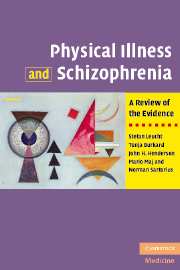4 - Discussion
Published online by Cambridge University Press: 08 August 2009
Summary
Most important findings of the review
The main finding of this review is that there are a number of physical diseases that are more frequent in people with schizophrenia than in the normal population. But there also seem to be a number of medical peculiarities in terms of physical diseases that are less frequent in schizophrenia. A summary of these conditions is provided in Table 4.1.
There were no clearly increased or decreased rates of physical diseases in the categories Parasitic Diseases, Digestive System Diseases, Otorhinolaryngologic Diseases, Eye Diseases, Hemic and Lymphatic Diseases, Congenital, Hereditary and Neonatal Diseases, Immune System Diseases, Disorders of Environmental Origin, Animal Diseases, Pathologic Conditions, Signs and Symptoms or these diseases were listed in another category. Please note that physical diseases that have only been shown to be related to the aetiology of schizophrenia (e.g. influenza virus during the pregnancies of mothers of children with schizophrenia) are not listed in Table 4.1.
On the whole, there are some areas that have been studied extensively (for example the comorbidity of neoplasms and schizophrenia for which a number of population-based studies from various countries exist), while other areas are still under-researched. Examples are Bacterial Infections and Virus Diseases. While mortality studies showed increased mortality due to infections in patients with schizophrenia, the evidence based on comorbidity studies is more limited. With the exception of HIV and, to a lesser extent hepatitis and tuberculosis, there is little evidence on the prevalence of infections in patients with schizophrenia.
- Type
- Chapter
- Information
- Physical Illness and SchizophreniaA Review of the Evidence, pp. 167 - 174Publisher: Cambridge University PressPrint publication year: 2007



